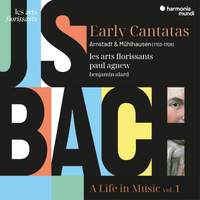Recording of the Week,
A new Bach cantata project from Les Arts Florissants
Bach’s Cantata No. 4, Christ Lag in Todes Banden, is one of the better-known of his cantatas - with its vivid imagery depicting the Easter story not merely as a metaphorical victory of life over death but as an actual war. After a pensive sinfonia (almost seeming to pick up where the Crucifixion narratives of the Passions leave off), the first chorus strikes a distinctly anxious note. The chorale melody is kept moving at a singable, realistic pace, which in turn imposes a brisk tempo on the other parts - almost like one of the whispering, conspiratorial turba choruses from the Passions.
For a while there was a school of thought that held that the faster you performed early music, the more authentic you were being, and having heard that opening - impressively agile and nimble though it is - I did wonder whether this performance would fall prey to the same thinking. Far from it; indeed there are hints of nostalgia for an era of performances that made up in heart what they lacked in scholarship. Hie ist das rechte Osterlamm is taken at an unusually slow speed, and resonant bass Edward Grint is clearly in touch with his inner Fischer-Dieskau - exuding assurance and confidence, echoed by lyrical phrasing in the strings.

Just as Concerti per una vita included a taste of what was fashionable in Vivaldi’s formative years, so too Agnew includes a contemporary cantata by Bach’s immediate predecessor at the Leipzig Thomaskirche, Johann Kuhnau. Cornetts, absent from the Bach, are very much in evidence here as part of the soundworld of Kuhnau’s heyday. Where Bach reserved the first statement of the chorale melody for the sopranos atop complex vocal counterpoint, Kuhnau’s choice to have the voices in octaves against a jumpy orchestral backdrop gives a real sense of firmly-planted, unshakeable Lutheran confidence. Ein’ feste Burg, one might say.
The ‘Osterlamm’ Passover imagery occurs here too; Kuhnau sets the verse as a limpid arietta for the tenor (an unpretentious, fluid Thomas Hobbs), sandwiched between two statements of an absolutely gorgeous ritornello. The second, which sees cornetts take over from violins, is particularly beautiful. It’s not quite the idyllic sound of a French Baroque air, but it’s not far off; I was disappointed to realise that there wasn’t more of it and immediately went back and played those three tracks again. I’m sure Kuhnau wouldn’t mind - indeed, that ritornello comes back a third time preceding the closing chorus. I suspect he knew he’d written something special and wanted to make full use of it.
For an album featuring two celebratory Easter cantatas, to end with the Actus Tragicus might seem a strange choice. Most likely written for a funeral, it seems not to fit the mood. Its opening sinfonia is one of Bach’s most moving instrumental passages, and I’ve always felt it could slot with no trouble into one of the more subdued, reflective moments of the St Matthew Passion.
In reality, though, the message is the same one of assurance and confidence; if the final chorus lacks the triumph and oomph of the two Christ Lag settings that frame Easter as a quasi-military victory, its rapid passagework and in particular the cheeky recorder coda (as if a couple of impertinent trebles were echoing the solemn ‘Amen’!) leave a decidedly optimistic impression.
‘A Life in Music’ isn’t intended to be a full cantata cycle, more of a guided tour - a selective exploration of works that illustrate key points in Bach’s life. Based on this first volume, I’m definitely on board.
Paul Agnew, Les Arts Florissants, Benjamin Alard
Available Formats: CD, MP3, FLAC, Hi-Res FLAC




